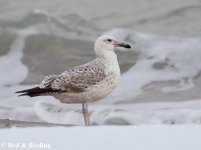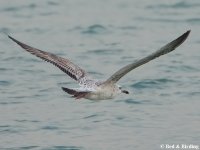-
Welcome to BirdForum, the internet's largest birding community with thousands of members from all over the world. The forums are dedicated to wild birds, birding, binoculars and equipment and all that goes with it.
Please register for an account to take part in the discussions in the forum, post your pictures in the gallery and more.
You are using an out of date browser. It may not display this or other websites correctly.
You should upgrade or use an alternative browser.
You should upgrade or use an alternative browser.
Large Gull ID (1 Viewer)
- Thread starter Pavel
- Start date
More options
Who Replied?Ighalo is amazing
Well-known member
Please help!
Where was this taken?
In my opinion this bird is a 2cy male caspian. My reasoning behind this is its long legs (especially tibia), large dip/bulge behind legs, mostly white head and breast, small rounded head and long parallel bill with a tapering end. The jizz overall is very bulky for normal caspian however birds like this can occur.
Thanks Dante
Last edited:
Pavel
Well-known member
Where was this taken?
Thanks Dante
NE Bulgaria, Durankulak beach.
Ighalo is amazing
Well-known member
NE Bulgaria, Durankulak beach.
What did you suspect the bird was? I am not familiar with the birds in that area. Are caspians regular there?
Thanks Dante
Pavel
Well-known member
What did you suspect the bird was? I am not familiar with the birds in that area. Are caspians regular there?
Thanks Dante
Yes, Caspians are regular in winter, but I suspected something bigger!
Ighalo is amazing
Well-known member
Yes, Caspians are regular in winter, but I suspected something bigger!
Some male caspians can get very big, this bird does not resemble a GBBG or anything else that i know off that is this size. Therefore I stick with my initial ID.
Thanks Dante
Nutcracker
Stop Brexit!
Agree with Ighalo, not a GBB!
phil baber
Clipped Wing

I'm leaning towards Caspian 2cyr too. A brute of a bird though! Seems to have lost some feathering at the bill base also?
pete wragg
Well-known member
It's not a 2cy(1st winter),look at the tertials.
pete.
pete.
lou salomon
the birdonist
oh yes, it is a 1st winter. an advanced male cachinnans which has fed and thus feathers near bill are wet.
upper tertials are 2nd generation as are many coverts, but note that most greater coverts are juvenile.
upper tertials are 2nd generation as are many coverts, but note that most greater coverts are juvenile.
pete wragg
Well-known member
oh yes, it is a 1st winter. an advanced male cachinnans which has fed and thus feathers near bill are wet.
upper tertials are 2nd generation as are many coverts, but note that most greater coverts are juvenile.
I've never seen a first winter with tertials like that. Infact I've never seen a second winter with tertials like that.
Agree the greater coverts do appear juvenile.
Always learning
KenM
Well-known member
I've never seen a first winter with tertials like that. Infact I've never seen a second winter with tertials like that.
Agree the greater coverts do appear juvenile.
Always learning
pete wragg
Well-known member
I've never seen a first winter with tertials like that. Infact I've never seen a second winter with tertials like that.
Agree the greater coverts do appear juvenile.
Always learning
I've not been able to find an image of a Caspan Gull,of any age,with tertials like these.
Not saying they don't exist,but can anyone provide a link?
pete.
Last edited:
You have to be a little more specific what you mean with "tertials like these". If you look closely enough, almost every gull tertial is unique in pattern, like fingerprints.
The problem is that first-year Caspian Gulls do not often moult their larger tertials, and you need to go through a largish number of individuals to see one. But when they do, the pattern of the new feathers may well be of this type.
This is not that different:
http://gull-research.org/cachinnans/2cy/l001754.html
The problem is that first-year Caspian Gulls do not often moult their larger tertials, and you need to go through a largish number of individuals to see one. But when they do, the pattern of the new feathers may well be of this type.
This is not that different:
http://gull-research.org/cachinnans/2cy/l001754.html
lou salomon
the birdonist
I've not been able to find an image of a Caspan Gull,of any age,with tertials like these.
Not saying they don't exist,but can anyone provide a link?
pee.
http://www.lou.bertalan.de/gulls/m_phi.php?bid=1352&grp=cachinnans 2cy january-june
pete wragg
Well-known member
Thanks Jalid and Lou.
I'm used to seeing scond generation tertials with a solid brown base and broad diffuse white tips,then the next generation uniform grey.Never seen them grey with dark cross bars.
Or maybe I've dismissed birds like this,because I thought this isn't what they should look like.
Pete
I'm used to seeing scond generation tertials with a solid brown base and broad diffuse white tips,then the next generation uniform grey.Never seen them grey with dark cross bars.
Or maybe I've dismissed birds like this,because I thought this isn't what they should look like.
Pete
lou salomon
the birdonist
Thanks Jalid and Lou.
I'm used to seeing scond generation tertials with a solid brown base and broad diffuse white tips,then the next generation uniform grey.Never seen them grey with dark cross bars.
Or maybe I've dismissed birds like this,because I thought this isn't what they should look like.
Pete
this is the type of 2nd gen. tertails which are moulted in early, during postjuvenile moult. the ones replaced in the following summer mostly look dark with broad pale distal part (and subterminal band). but you would be surprized, maybe, if you see the variance in 1st gen. caspian tertials also
Last edited:
Similar threads
- Replies
- 4
- Views
- 560
Users who are viewing this thread
Total: 2 (members: 0, guests: 2)





